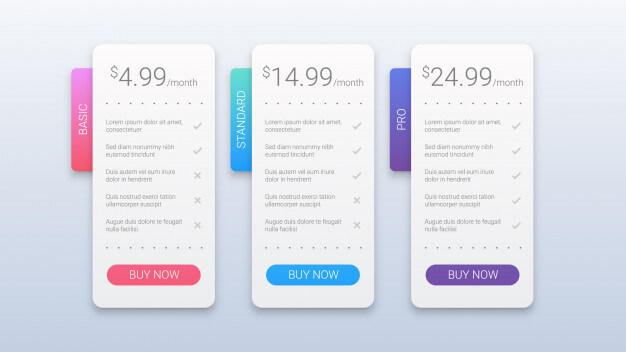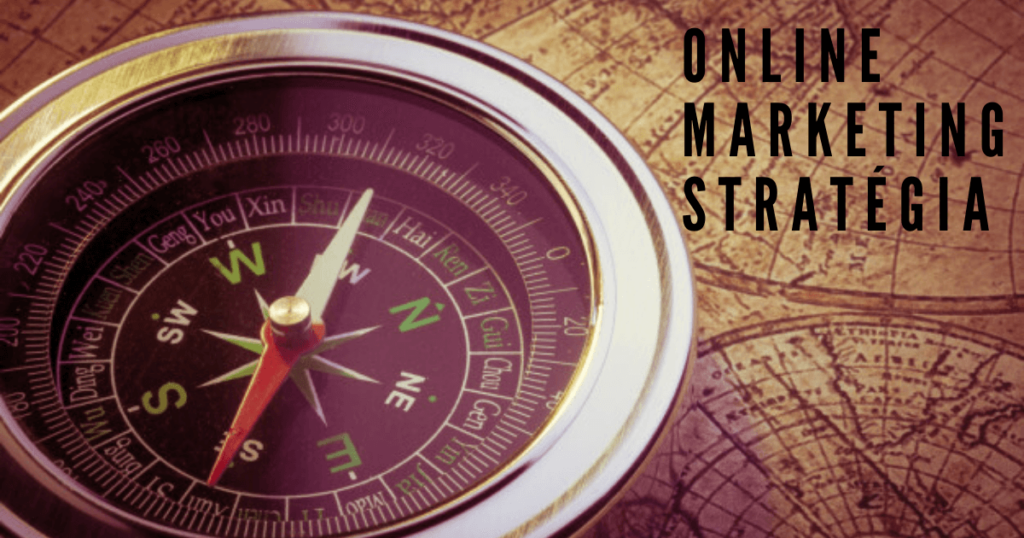What is a good online marketing strategy? And what is it good for anyway? What happens if you don’t have one? Don’t worry, no cute bunnies will die in the distance and your company might not go bankrupt next year. But it is certain that without planning, a lot of your money will be wasted on marketing. And you won’t even come close to taking advantage of opportunities to increase revenue.
The basic principle is that a marketing strategy should always be part of your business strategy. It helps you to achieve your business goals, so it’s a good idea to dig into your business plan before you go wild with your marketing strategy. If you don’t already have one, then I recommend you get started. Because at the very least you’ll need well-set goals, a financial plan or at least a medium-term cash flow plan and an operational plan to make sense of planning an online marketing strategy. Don’t overcomplicate it, you can find countless planning guides on the internet too. The key is to have a clear vision of your business goals and the steps to get there. This helps you to communicate this simply and quickly to colleagues, management, investors, or even an online marketing agency.
Once you have your business plan for the coming year, get out your pencil and paper, take a few hours and develop your online marketing strategy. Write it down, structure it, and probably already have it in your head in detail.
1. Define your online marketing strategy
“No wind is in favour of someone who doesn’t know which port he is heading for.”
Seneca
Until you know what your exact goals are, it will be difficult to achieve them. Set your goals using the so-called SMART method:
S – specific
M – measurable
A – achievable
R – relevant
T – time-boxed
Example of a good smart objective:
In 2024, I will acquire 6 new clients for my marketing agency from the healthcare sector for complex marketing execution.
Specific, quantified, time-boxed, measurable, relevant and achievable target.
Goals of the “I will be more successful in the future, earn more money and have less stress” type are not appropriate here because they do not meet any of the above criteria.

The biggest mistake you can make when setting goals is not being realistic about the outcomes you want to achieve. If you are currently generating 1 million HUF per month from your online shop, it is not realistic to aim for 12 million HUF in sales without changing your product structure, prices or investing several times more than you are currently spending on marketing.
It’s also a mistake to leave too short a timeframe for development. We often get requests that someone wants to increase their revenue three or four times in 1 month, without spending more on marketing, or changing their product & pricing policy. There are no miracles and if someone does promise to do so, I would be quick to run away. They probably don’t have enough experience or are simply projecting).
2. Target group analysis
Never lose sight of who you are selling to. Set up your own buyer personas: with common sense, think about who you are giving the most value to with your products and services. There is no such thing as something for everyone. What is it that everyone from grandma in Bangladesh to mom in New York to kindergartener in Nagykanizsa needs and would buy from you at the same time? Well, yeah. Be very specific: think about the main characteristics of your typical customer (and better still, ask them!):
- Male or female?
- How old?
- Do they have a family?
- How much do they earn?
- How much do they spend?
- How do they spend a day?
- How do they get to work?
- What do they read or watch?
- How do they spend their free time?
- What are their main problems at work?
- What is their main personal problem?
- How much time do they have for their family, entertainment?
- What is their main source of pleasure?
- What can you do to help them?
All this is important, not for the sake of being naughty, but to help you decide which marketing channels will be most valuable and useful to you. Believe me, that’s exactly what the most professional online marketing agencies do.

3. Price strategy is also important for a good marketing strategy
You can read countless books and studies on this topic in both English and Hungarian, but the point is that it is part of online marketing strategy. The most common pricing models:
If you’ve had a business for years, you hopefully have an established pricing strategy, but it’s never too late to rethink and modernise it. It is important to be clear about your break-even point: when it becomes worthwhile to sell a product. Why is this important? If you make 100 cents on a product, it’s not worth it to have a Facebook ad that brings you customers for 150 cents. If you run your business alone and have the capacity for 40 units of your service per month, then it is unnecessary to bring in online marketing resources that will increase the number of orders to 80. You will not be able to service those customers. Unless of course you hire new people, but that is not part of your online marketing strategy.
Some well-known pricing methods
- Cost-based: the most common pricing method used for products: you calculate how much it costs to produce a product and then add your profit, which becomes the selling price.
- Value-based: the most common pricing model for services: you calculate how much value you produce for your customers, and set your prices based on that.
- Competitor-based: you look at what your competitors are charging and adjust your prices accordingly (personally, I’m not a fan of this, because you’re going after the market, not before it).
- Mixed pricing: I use this myself. I calculate how many man-hours we need to do a job, multiply that by the hourly rate of the staff coming in, and look at the value we create. And, of course, I constantly monitor our competitors’ prices and adjust our prices if necessary.
Work at prices that leave you money for marketing (online marketing agency, advertising costs, product development, promotions).

4. Competitor analysis
It’s good to know exactly who you’re competing with! To know what’s going on in your market – so competitor analysis is part of your online marketing strategy.
First, list all the companies that offer the same or very similar products and services to your target group. In our case, for example, this is all the agencies that provide online marketing execution. Narrow this down to those whose operations really have an impact on you. Going back to our example: there would not be enough working days to analyse all the Hungarian marketing companies, there are so many. So I’ll narrow down the competitor analysis to those who do not only consultancy but also implementation. And then to those who provide services to SMEs – so that leaves out the multi-agencies.
I also exclude one-person firms, because a one or two-person firm is quite different from a 10-person team of experts – different work organisation, pricing, etc. Also excluded are marketing agencies that are known to be of poor quality, and I do not consider them to be competitors at any level. This leaves me with 5-8 companies that I consider to be real competitors in the Hungarian market. I should note here that I do not use the word “competition” in a negative sense, in fact! I know these companies personally, we are almost friends.. We meet from time to time to discuss industry trends. We inspire and encourage each other to perform better!
What are the criteria for assessing competitors in your online marketing strategy?
- Product: how is the quality of their product, how does it compare to yours (listen, be honest! If their product is better, admit this to yourself and try to improve your own, or price it lower, or compensate somehow for the difference)
- Price: what price they work for, what they sell for
- Turnover: look up from a public database what their turnover was, their statistical headcount, their profits, their dividends, and the change from previous years. You will find a lot of exciting information:)
- Website: what is the quality of the website, what is the loading speed, how much information is on it, what is the quality of the images, what is the quality of the text, what is it like from an SEO point of view, how are the processes working, what guarantees do they offer, what are the delivery terms – look at all aspects that are relevant to your product
Tip: use similarweb.com to access public data.
- Social media: where are they present? Facebook, Instagram, LinkedIn, Pinterest, TikTok. How big is your follower base? How often do they post and on what topics, and in what quality? What are they doing well and what are they not?
- Customer reviews: see what kind of feedback they get from customers. The easiest way to find out is to look at Facebook and Google My Business reviews: find out what their strengths and weaknesses are.
- Visible marketing processes: do they have a newsletter? What about a blog? How often do they take action? Who are their collaborative partners?
This is a lot of info – how should I organise it?
Once you’ve gathered all the info, make a spreadsheet where you sort the info side by side (I include myself in this analysis to simply see what’s going on). And what to do with the table? Simple! Look at where you need to improve. What you can learn from your competitors and see where they are making mistakes. Your task is this: be better than them!

5. Market research is part of your online marketing strategy
If you’ve done your competitor analysis thoroughly, you’ve already done the first half of the market research. Now look at what your target group expects from you and your product! What is important to them? Price or quality? Fast delivery or a money-back guarantee? What is their most important problem with the situation? (E.g. with a recipe search app: Don’t have time to cook, don’t like to shop, or never have an idea? Once you have the answers, it’s much easier to find the key messages and the right tools (see next point).
There are basically two different methods when it comes to market research:
- Qualitative research: it does not give quantitative results, but helps to understand the mindset and expected reactions and actions of the target group. The most common methods are focus group interviews, in-depth interviews and field research. Its advantage is that many problems may come up that you had not thought of before. Its disadvantages are that it can be expensive in professional settings and that it is highly subjective and the personality of the interviewer and the quality of the questions can strongly influence the results.
Tip: In practice (if you don’t want to do it with laboratory precision), sit down for a chat with your target group, for example a current client. Ask them what is causing them problems that your product or service could solve. Ask him how easy it is to use, how he finds the service, pricing, etc. Let him explain his thoughts in detail and take notes diligently!

- Quantitative research: quantifies data and usually uses statistical analysis, the most typical form being questionnaires or analysis of existing data. You can do research on a large sample, but be careful, you can only produce truly representative results at SME level almost exclusively with the help of a market research company, but in my opinion you don’t need to. The advantage is that you can collect relevant information cheaply, even with a free Google Survey. The disadvantage is that if you choose the wrong sample, the results can be very distorted.
Tip: create a Google questionnaire asking about the most important issues and then get it to as many people in your target audience as possible. Put it on your social media pages, send it out in a newsletter, run paid advertising on it, then analyse the results and use them in your online marketing strategy.
6. Messages
If you’ve done the above steps honestly, you’ve probably already found the message (or rather messages associated with buyer personas) that best describe your product or service and best highlight the solution to your target audience’s problems.
Never start with yourself! It’s not about what you like, what sounds good to you. You’re biased towards your company, you’ve dug in, you’ve got a deep knowledge of the subject. The important thing is what your target audience needs – perhaps this unemotional insight is why you should most consider hiring a professional online marketing agency. It’s no use communicating that your luxury product is the cheapest in its category if your customers are buying it precisely to use it as a status symbol. In such cases, a misguided message can cost you the whole sale, even if you have the perfect product, good pricing and good advertising.
Be concise, pithy, easy to understand. A good message is no more than 10 words (which is all the brain can comfortably take in while reading) and it’s never about you. No one cares that your company is 10 years old and that you are a top quality company (everyone says the same thing about themselves). What matters is what your product does for me! Will my new phone make me cooler? Can I cook healthier meals for my family? Can I get to my business meetings faster? Does your perfume make women/men turn around after me on the street?
Tip: Try not to communicate a product feature but a benefit. The fact that a perfume smells good and lasts long is a feature. Being irresistible to the opposite sex all night long is a product benefit for buying the perfume.

7. Tools, channels
Once you know what your product’s biggest advantage is, and you know exactly who you want to sell to, define in your online marketing strategy the channels you will use to communicate.
The range of options is very wide, it’s always the goals you have and the resources you have (mostly time and money) that determine what you use.
You should definitely consider the following tools and channels when planning your online marketing strategy:
- Website
- SEO
- Google Ads
- Blog
- Newsletter
- TikTok
- Flu collaborations
- Videos
- Affiliate Partnerships
- PR
- Events
- Podcast

8. Timing
Finally, once you have chosen your channels, time your campaigns for the whole year. Make sure that you do not just time the specific campaigns, but also allow for preparation time, and possibly “campaign warm-up”. If you’re planning a Christmas campaign from 10 November, your website should be up and running perfectly by then, your stock should be at max, your email list should be fresh and crisp. There are many little things that can cause a well-planned campaign to fail (e.g. your website crashes because it can’t cope with the increased traffic, your credit card expires on the fly or runs out and your ads stop working, the buy button doesn’t work, Facebook blocks your ads, etc.), so it’s worth testing the whole system live before the campaigns.
Ideally, of course, you don’t have one or two campaigns a year, but you’re constantly working throughout the year, e.g. on increasing your brand awareness, list building, website optimisation, content production. Have priority and base periods. During high priority periods (summer campaigns, Christmas, Black Friday) focus on sales, on serving your customers as effectively as possible, and between major campaigns focus on achieving your other marketing goals.
How far ahead should a marketing strategy look?
It’s also a good idea to plan a year in advance, because if you need to bring in outside help to help you execute (copywriter, graphic designer, online marketing agency), you have time to ask for bids from several places, sit down with them, talk to them, see if there’s chemistry between you, if they understand your goals and how you operate. We wrote about choosing an online marketing agency here. If you’re thinking of working with an agency on November 1, the best ones probably can’t even give you a quote in such a short time, let alone a full implementation.
Tip: don’t just schedule campaigns into your calendar, but evaluate how you’re doing against your goals at least quarterly. If you really do this every 3 months, then you have plenty of opportunity to make adjustments and change your methods, but if you realise at the end of the year that you are not even close to the numbers you had dreamed of, by December you will have no choice but to cry in the corner, bang your head against the wall or berate your partners for poor performance.

9. Budget
There are two approaches, and both can be effective.
Cost-based planning
The first – especially for start-ups or smaller companies – is to calculate how much money you can spend on marketing and see what fits into that budget. So you plan your achievable goals according to your possibilities. Be realistic: you can’t work with an agency, run professional Google Ads and Facebook campaigns on 200,000 HUF a year and still be active on social media.
There are a lot of parts of online marketing that you can do yourself with a little learning and a lot of time, such as social media communication, Facebook and Instagram posting, blogging. And there are some things you should leave to an expert from a relatively early stage: PPC campaigns, Facebook, Instagram, Google ads should be run with great expertise, because apart from being inefficient, you risk a lot of money.
Consider whether you can invest more time or money, because you will definitely need one of the two. It is also important to match your goals to your budget, because it will not be realistic to launch an unknown brand from scratch with 100.000 HUF in a market where you have to compete with multinationals and you want to generate 2 million HUF in 3 months from products with 1500 HUF.
Planning target-based spending
The second version, which is already typical for businesses with a larger budget, is to take a number of targets to achieve and see how much marketing budget you need to achieve them. In this case, you’ll also need to factor in the planning of a marketing strategy, an implementation team (this could be yourself, working with in-house marketers, freelancers and an online marketing agency), and the amount you’ll spend on advertising (paid to Google, Facebook, media sites, printers, etc.). In this case, you have specific goals, e.g. 30% increase in sales, so you can calculate how much marketing budget you can achieve this goal with based on your previous experience or with the help of an online marketing expert.

Summary
I do not recommend starting any online marketing activity without planning, as you are likely to end up disappointed. Plan what you want to achieve, how much money you have, what exactly you want to market and to whom, so that – if you have set realistic goals and have done your planning homework honestly and consistently stick to them – your online marketing will almost certainly be successful.
I appreciate you sharing this article, because many, many entrepreneurs should be making plans for the future right now 🙂 If you’re stuck, or feel it’s too much for you to handle and would rather leave it to a professional online marketing agency, then feel free to contact us and we’ll help you plan your online marketing strategy.




